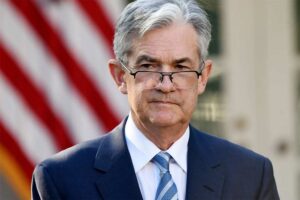Introduction:
Gold, a widely recognized safe-haven asset, has experienced subdued trading around the $1,960 per ounce mark on Wednesday. Investors are eagerly anticipating the upcoming US Federal Reserve interest rate decision, as well as closely monitoring global economic indicators and trade signals. In this article, we will delve into the factors influencing gold’s performance, including the potential impact of the global economy, the strength of the US dollar, and trade signals affecting investor sentiment.
The US Federal Reserve’s Interest Rate Decision and Economic Outlook Transition:
As investors gear up for the US Federal Reserve’s interest rate decision next week, gold’s price remains in focus amidst economic uncertainties. In the current economic climate, the Federal Reserve is widely expected to pause its tightening cycle at the upcoming meeting. Softening US economic data has prompted market participants to anticipate a temporary halt to interest rate hikes. However, despite this expectation, markets still assign a nearly 52% chance of another 25 basis point rate hike in July. This uncertainty has contributed to gold’s subdued performance, as investors assess the potential implications of interest rate changes on the precious metal’s value.

US Inflation Data and its Impact on Gold Transition:
Investors eagerly await the release of US inflation data next week, as it will provide crucial insights into the economic and interest rate outlook. Inflation is a key driver of market sentiment and plays a significant role in shaping gold’s performance. As the Federal Reserve monitors inflationary pressures, investors closely analyze the upcoming data to gauge the likelihood of rate adjustments. Persistent inflationary pressures have led major central banks to consider maintaining higher interest rates for an extended period, thus affecting the attractiveness of gold as an alternative investment.
Gold’s Performance and the Global Economy Transition:
The global economy’s performance and its impact on gold prices remain critical factors to consider.
While gold has witnessed a decline of more than 5% from its May peak, the broader global economic landscape plays a crucial role in shaping the precious metal’s performance. Central banks worldwide are grappling with the challenge of managing inflationary pressures, which has led to expectations of prolonged periods of higher interest rates. These dynamics create uncertainty and affect investor sentiment towards gold, as it competes with other assets for capital allocation.

Trade Signals and Gold’s Market Outlook Transition:
Trade signals serve as a vital component in assessing gold’s market outlook and investor sentiment. The global trade landscape and its influence on the economy are important considerations for gold investors. Recent data revealed that Chinese exports dropped more than expected in May, highlighting the challenges faced by the country’s recovery path amid slowing external demand. Such developments impact global economic growth prospects and can result in shifts in investor preferences for safe-haven assets like gold.
The Impact of the US Dollar on Gold Prices Transition:
The strength of the US dollar is a significant determinant of gold’s performance. The US dollar’s value often has an inverse relationship with gold prices. A stronger dollar tends to make gold more expensive for holders of other currencies, potentially dampening demand. Conversely, a weaker dollar can make gold relatively more affordable, bolstering its appeal. As investors navigate uncertainties surrounding the US dollar’s strength, they closely monitor the currency’s fluctuations for potential implications on gold prices.
Conclusion:
In conclusion, gold’s subdued performance around $1,960 an ounce reflects the cautious stance of investors awaiting the US Federal Reserve’s interest rate decision and assessing global economic indicators. As trade signals and the global economy continue to evolve, gold’s outlook remains subject to various factors, including US inflation data, the strength of the US dollar, and the interplay between major central banks. Staying informed about these dynamics is crucial for investors seeking to navigate the intricacies of the gold market and make informed decisions in this ever-changing landscape.






mexican pharmacy: cmq pharma – mexican rx online
canadian pharmacy prices: canadian online drugs – best mail order pharmacy canada
adderall canadian pharmacy best canadian online pharmacy reviews reputable canadian online pharmacy
canadian pharmacy drugs online: the canadian drugstore – best canadian online pharmacy
Online medicine home delivery: india online pharmacy – indian pharmacies safe
https://canadapharmast.com/# cheap canadian pharmacy
canadian valley pharmacy canadian king pharmacy canada drug pharmacy
http://canadapharmast.com/# vipps canadian pharmacy
canada drugs online reviews: legitimate canadian mail order pharmacy – online canadian drugstore
mexican border pharmacies shipping to usa buying prescription drugs in mexico online buying prescription drugs in mexico
canadian mail order pharmacy: buying drugs from canada – reliable canadian pharmacy reviews
https://canadapharmast.com/# best rated canadian pharmacy
online shopping pharmacy india: india online pharmacy – buy medicines online in india
buy prescription drugs from india: mail order pharmacy india – reputable indian pharmacies
canadian pharmacies comparison reliable canadian pharmacy northwest pharmacy canada
medicine in mexico pharmacies: pharmacies in mexico that ship to usa – mexican rx online
canadian drug stores: canadian family pharmacy – canadian drug prices
https://canadapharmast.online/# legit canadian pharmacy online
mexico pharmacies prescription drugs mexico drug stores pharmacies best online pharmacies in mexico
indian pharmacies safe: Online medicine order – world pharmacy india
cheapest online pharmacy india: indian pharmacy – india pharmacy mail order
real canadian pharmacy medication canadian pharmacy canadian pharmacies
https://indiapharmast.com/# reputable indian pharmacies
indian pharmacy: cheapest online pharmacy india – india pharmacy
top 10 online pharmacy in india: online shopping pharmacy india – reputable indian pharmacies
http://indiapharmast.com/# india pharmacy mail order
legitimate canadian pharmacy online cheap canadian pharmacy drugs from canada
amoxicillin order online no prescription: amoxicillin 500 mg for sale – can i buy amoxicillin online
https://clomiddelivery.pro/# clomid brand name
http://ciprodelivery.pro/# buy cipro online without prescription
doxycycline 1000mg buy doxycycline online cheap doxycycline capsules
http://clomiddelivery.pro/# can i get clomid prices
can you get generic clomid pills: how can i get cheap clomid online – can i order cheap clomid pills
https://doxycyclinedelivery.pro/# doxycycline 75 mg capsules
http://clomiddelivery.pro/# how can i get cheap clomid for sale
paxlovid pharmacy buy paxlovid online paxlovid india
https://paxloviddelivery.pro/# paxlovid india
paxlovid india: buy paxlovid online – paxlovid for sale
https://amoxildelivery.pro/# buy cheap amoxicillin online
http://ciprodelivery.pro/# cipro
https://amoxildelivery.pro/# 875 mg amoxicillin cost
doxycycline purchase doxycycline 300 mg price doxycycline online purchase
https://doxycyclinedelivery.pro/# buying doxycycline uk
buy paxlovid online: paxlovid buy – paxlovid price
https://ciprodelivery.pro/# where can i buy cipro online
http://ciprodelivery.pro/# where can i buy cipro online
amoxicillin 500mg capsules uk amoxicillin without prescription amoxicillin over the counter in canada
http://clomiddelivery.pro/# where to buy generic clomid without a prescription
paxlovid cost without insurance: paxlovid for sale – paxlovid for sale
https://ciprodelivery.pro/# where can i buy cipro online